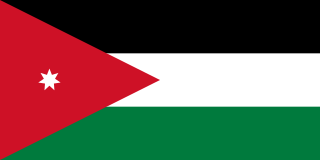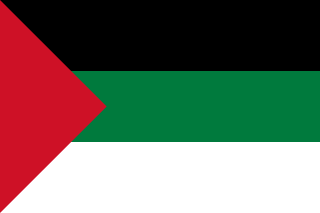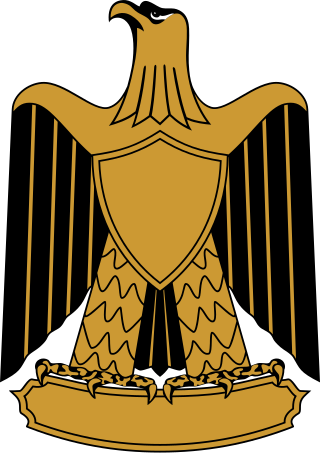
The pan-Arab colors are black, white, green and red. Individually, each of the four pan-Arab colors were intended to represent a certain aspect of the Arab people and their history. [1]

The pan-Arab colors are black, white, green and red. Individually, each of the four pan-Arab colors were intended to represent a certain aspect of the Arab people and their history. [1]

The black represents the Black Standard used by the Rashidun and Abbasid Caliphates, while white was the dynastic color of the Umayyad Caliphate. [3] Green is a color associated with the primary religion of Islam – and therefore also a color representative of the caliphates. [4] [5] Green is also identified as the color of the Fatimid Caliphate by some modern sources, [3] [6] despite their dynastic color having been white. [7] [8] [9] Finally, red was the Hashemite dynastic color. The four colors also derived their potency from a verse by 14th century Arab poet Safi al-Din al-Hilli: "White are our acts, black our battles, green our fields, and red our swords." [10]
Pan-Arab colors, used individually in the past, were first combined in 1916 in the flag of the Arab Revolt or Flag of Hejaz. [11] Many current flags are based on Arab Revolt colors, such as the flags of Jordan, Kuwait, Palestine, the Sahrawi Arab Democratic Republic, and the United Arab Emirates. [12]
In the 1950s, a subset of the Pan-Arab colors, the Arab Liberation colors, came to prominence. These consist of a tricolor of red, white and black bands, with green given less prominence or not included. The Arab Liberation tricolor or the Arab Liberation Flag was mainly inspired by the Egyptian Revolution of 1952 and Egypt's official flag under president Mohamed Naguib. [13] which became the basis of the current flags of Egypt, Iraq, Sudan, Syria and Yemen (and formerly in the flags of the rival states of North Yemen and South Yemen), and in the short-lived Arab unions of the United Arab Republic and the Federation of Arab Republics. [12]

The Fatimid Caliphate or Fatimid Empire was a caliphate extant from the tenth to the twelfth centuries CE under the rule of the Fatimids, an Isma'ili Shia dynasty. Spanning a large area of North Africa and West Asia, it ranged from the western Mediterranean in the west to the Red Sea in the east. The Fatimids trace their ancestry to the Islamic prophet Muhammad's daughter Fatima and her husband Ali, the first Shia imam. The Fatimids were acknowledged as the rightful imams by different Isma‘ili communities as well as by denominations in many other Muslim lands and adjacent regions. Originating during the Abbasid Caliphate, the Fatimids conquered Ifriqiya and established the city of al-Mahdiyya. The Fatimid dynasty ruled territories across the Mediterranean coast and ultimately made Egypt the center of the caliphate. At its height, the caliphate included—in addition to Egypt—varying areas of the Maghreb, Sicily, the Levant, and the Hejaz.
The Fatimid dynasty was an Arab dynasty that ruled the Fatimid Caliphate, between 909 and 1171 CE. Descended from Fatima and Ali, and adhering to Isma'ili Shi'ism, they held the Isma'ili imamate, and were regarded as the rightful leaders of the Muslim community. The line of Nizari Isma'ili imams, represented today by the Aga Khans, claims descent from a branch of the Fatimids. The Alavi Bohras, predominantly based in Vadodara, also claim descent from the Fatimids.

The national flag of Saudi Arabia, also known as the al-Alam, is a green background with Arabic inscription and a sword in white. The inscription is the Islamic creed, or shahada: "There is no deity but God; Muhammad is the Messenger of God". The current design has been used by the government of Saudi Arabia since 15 March 1973.

The flag of Jordan, officially adopted on 16 April 1928, is based on the 1916 flag of the Arab Revolt against the Ottoman Empire during World War I. The flag consists of horizontal black, white, and green bands that are connected by a red chevron. The colours are the Pan-Arab Colors, respectively representing the Abbasid, Umayyad, and Fatimid or Rashidun caliphates. The red chevron is for the Hashemite dynasty, and the Arab Revolt.
As a result of the Syrian Civil War since 2011, there are at least two flags used to represent Syria, used by different factions in the war. The incumbent government of the Syrian Arab Republic led by the Ba'ath Party uses the red-white-black tricolour originally used by the United Arab Republic, while Syrian opposition factions such as the Syrian National Coalition use the green-white-black tricolour known as the ''Independence flag'', first used by Mandatory Syria.

Bilad al-Sham, often referred to as Islamic Syria or simply Syria in English-language sources, was a province of the Rashidun, Umayyad, Abbasid, and Fatimid caliphates. It roughly corresponded with the Byzantine Diocese of the East, conquered by the Muslims in 634–647. Under the Umayyads (661–750) Bilad al-Sham was the metropolitan province of the Caliphate and different localities throughout the province served as the seats of the Umayyad caliphs and princes.

A caliphate or khilāfah is an institution or public office under the leadership of an Islamic steward with the title of caliph, a person considered a political-religious successor to the Islamic prophet Muhammad and a leader of the entire Muslim world (ummah). Historically, the caliphates were polities based on Islam which developed into multi-ethnic trans-national empires. During the medieval period, three major caliphates succeeded each other: the Rashidun Caliphate (632–661), the Umayyad Caliphate (661–750), and the Abbasid Caliphate (750–1517). In the fourth major caliphate, the Ottoman Caliphate, the rulers of the Ottoman Empire claimed caliphal authority from 1517 until the caliphate was formally abolished as part of the 1924 secularisation of Turkey. Throughout the history of Islam, a few other Muslim states, almost all of which were hereditary monarchies such as the Mamluk Sultanate and Ayyubid Sultanate, have claimed to be caliphates.

The coat of arms of Egypt is known as the Republican Eagle or Egyptian Golden Eagle, is a heraldic golden eagle, facing the viewer's left (dexter). The eagle's breast is charged with an escutcheon bearing the red-white-black bands of the flag of Egypt rotated vertically, whilst the eagle's talons hold a scroll bearing the official name of the state written in Kufic script. The earliest version of the Eagle of Saladin was that used as the flag of Saladin, the first Sultan of Egypt, whilst the modern version of the eagle was adopted during the Egyptian Revolution of 1952. Subsequently, the modern design of the eagle of Saladin was adopted as the coat of arms of numerous other states in the Arab World, such as the United Arab Republic, North Yemen, Iraq, South Yemen, the Libyan Arab Republic, and Palestine. The current eagle was modified in 1984 to its present form.

The Black Banner or Black Standard (Arabic: الراية السوداء, romanized: ar-rāyat as-sawdāʾ, also known as راية العقاب is one of the flags flown by the Islamic prophet Muhammad according to Muslim tradition. It was historically used by Abu Muslim in his uprising leading to the Abbasid Revolution in 747 and is therefore associated with the Abbasid Caliphate in particular. It is also a symbol in Islamic eschatology though this tradition is weak according to hadithic standards.

An Islamic flag is the flag either representing an Islamic Caliphate, religious order, state, civil society, military force or other entity associated with Islam. Islamic flags have a distinct history due to the Islamic prescription on aniconism, making particular colours, inscriptions or symbols such as crescent-and-star popular choices. Since the time of the Islamic prophet Muhammad, flags with certain colours were associated with Islam according to the traditions. Since then, historical Caliphates, modern nation states, certain denominations as well as religious movements have adopted flags to symbolize their Islamic identity. Some secular states and ethnic or national movements also use symbols of Islamic origin as markers of heritage and identity.

The coat of arms of Palestine may refer to the emblem used by the State of Palestine and Palestinian National Authority (PNA) or to the emblem used by the Palestine Liberation Organization (PLO).
The Banu Sulaym is an Arab tribe that dominated part of the Hejaz in the pre-Islamic era. They maintained close ties with the Quraysh of Mecca and the inhabitants of Medina, and fought in a number of battles against the Islamic prophet Muhammad before ultimately converting to Islam before his death in 632. They took part in the Muslim conquest of Syria, and established themselves in the Jazira, while part of the tribe remained in the Hejaz. During the early Muslim period, the tribe produced notable generals such as Safwan ibn Mu'attal, Abu'l-A'war and Umayr ibn al-Hubab. Those who remained in Arabia were largely absorbed by the Banu Harb of Yemen beginning in the 9th century, while those in Syria and the Jazira were expelled to Upper Egypt by the Fatimid Caliphs in the late 10th century for supporting the Qarmatians. In the mid-11th century, a prolonged famine in Egypt prompted the tribe to migrate westward with the Banu Hilal into Libya. There, the Sulaym and its sub-tribes established themselves mainly in Cyrenaica, where to the present day, many of the Arab tribes of that region trace their descent to the Sulaym.

The Tayy, also known as Ṭayyi, Tayyaye, or Taiyaye, are a large and ancient Arab tribe, among whose descendants today are the tribes of Bani Sakher and Shammar. The nisba (patronymic) of Tayy is aṭ-Ṭāʾī (ٱلطَّائِي). In the second century CE, they migrated to the northern Arabian ranges of the Shammar and Salma Mountains, which then collectively became known as the Jabal Tayy, and later Jabal Shammar. The latter continues to be the traditional homeland of the tribe until the present day. They later established relations with the Sasanian and Byzantine empires.

The color green has a number of traditional associations in Islam. It holds profound traditional associations within Islam, embodying themes of paradise, purity, and prosperity. In the Quran, green is linked with paradisiacal imagery, symbolizing the serenity of paradise. Green was adopted by the Shi'ites, and remains particularly popular in Shi'ite iconography, but it is also widely used in by Sunni states, notably in the flag of Saudi Arabia and the flag of Pakistan. Green's subsequent incorporation into national flags highlights the enduring significance in Islamic iconography.

The flag of the Arab Revolt, also known as the flag of Hejaz, was a flag used by Hussein bin Ali and his allies, the Arab nationalists, during the Arab Revolt against the Ottoman Empire during World War I, and as the first flag of the Kingdom of Hejaz. It was designed by Mark Sykes but is highly reminiscent of previous Arab flags, such as the flags of the al-Muntada al-Adabi, al-ʽAhd and al-Fatat.
The Umayyad dynasty or Umayyads was an Arab clan within the Quraysh tribe who were the ruling family of the Caliphate between 661 and 750 and later of al-Andalus between 756 and 1031. In the pre-Islamic period, they were a prominent clan of the Meccan tribe of Quraysh, descended from Umayya ibn Abd Shams. Despite staunch opposition to the Islamic prophet Muhammad, the Umayyads embraced Islam before the latter's death in 632. Uthman, an early companion of Muhammad from the Umayyad clan, was the third Rashidun caliph, ruling in 644–656, while other members held various governorships. One of these governors, Mu'awiya I of Syria, opposed Caliph Ali in the First Muslim Civil War (656–661) and afterward founded the Umayyad Caliphate with its capital in Damascus. This marked the beginning of the Umayyad dynasty, the first hereditary dynasty in the history of Islam, and the only one to rule over the entire Islamic world of its time.

The Eagle of Saladin, known in Egypt as the Egyptian Eagle, and the Republican Eagle, is a heraldic eagle that serves as the coat of arms of many countries; Egypt, Iraq, Coat of arms of the Kurdish autonomous region of Iraq (KRG), Palestine, and Yemen. Since the Egyptian 1952 coup d'etat, the eagle has been an iconic symbol of Egypt, and of Arab nationalism, particularly in Arab states that underwent anti-imperialist political change from the 1950s onwards. It was formerly the national symbol of the now defunct United Arab Republic, North Yemen, South Yemen, and the Libyan Arab Republic.

The recorded history of the Arabs begins in the mid-9th century BCE, which is the earliest known attestation of the Old Arabic language. Tradition holds that Arabs descend from Ishmael, the son of Abraham. The Syrian Desert is the home of the first attested "Arab" groups, as well other Arab groups that spread in the land and existed for millennia.
The Ismaili Shi'ite counter-caliphate founded by the Fatimids took white as its dynastic color, creating a visual contrast to the Abbasid enemy.
...white was also the color associated with the Fatimid caliphs, the opponents of the Abbasids.
...wore white (the Fatimid color) while delivering the sermon (khuṭba) in the name of the Fatimid caliph.
The designs of these flags were later modified, but the four pan-Arab colors were retained and were adopted by Transjordan (1921), Palestine (1922), Kuwait (1961), the United Arab Emirates (1971), Western Sahara (1976) and Somaliland (1996).